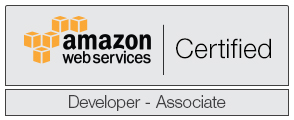I have briefly mentioned about how I prepared for the other AWS certifications – Solution Architect and SysOps Administrator in other posts. I cleared my AWS Developer certification last week. It was indeed developer focused, which translates to heavy coverage of DynamoDB, CloudFormation, ElasticBeanstalk, SQS, SNS, Opsworks. DynamoDB stood out without any doubt.

Few interesting points – there were questions on command line, knowledge on hard limits and soft limits in AWS services, emphasis on usage of SDK (SDK user would be able to answer that question without a doubt). I am a developer not inclined to any particular platform but a more of a generic guy with bit of js, .net and python.
I have been working on AWS (and other random stuff – Azure, Office 365, Talend, Robotic Process Automation, devops) for around 6 years and I never really took a learning path to for AWS certification – associate level. I took my AWS Solution Architect by mid 2014, SysOps by mid 2015, solution architect recertification by mid of 2016 and developer certificate couple last week (end of 2016) (working on my professional level).
I would recommend the following learning path for someone who would want to face the AWS Certified Developer certification.
- VPC, Subnets, Security Groups, Elastic IP, Public IP, Private IP – have this by heart by all means. (although this is pretty much applicable for all the AWS certifications)
- EC2, AMI – try launching & relaunching in different AZ, different region, change size, change application version, snapshots – attach & detach
- S3 is really important – method of securing S3 items (ACL, IAM) – static web site, logging, storage classes and GLACIER [ I want to thank Craig Carl for his re:Invent session – please spend time in this video you would also thank Craig Carl when you face the certification)
- I would recommend ditching AWS management console for couple of weeks and using with AWS CLI and that should level up your skills in IAM Access Key – Secret Key, and understand the AWS API nature. Bonus points is when you try aws-shell.
- I remember watching one of the youtube videos by Matt Wood himself where he starts all the way from 101 in DynamoDB. I would recommend trying to build a web application using one of the SDKs with DynamoDB as backend + some CRUD application should help you get your hands dirty in DynamoDB. Please spend time, effort, money, social life on indexes in dynamodb.
- Try releasing the above application to the wide through OpsWorks and Beanstalk that would be help check lot of items in the exam blue print
- Try using RDS, SNS, SQS wherever and however possible
- If you are able to meaningfully represent the above stated items over a CloudFormation you are good to go here. I am bragging this.
- FAQs are super important for the services – I would do this multiple times before facing the certification exam
- All the patterns and anti-patterns (When do you CloudFormation vs Elastic BeanStalk, AMI vs user data, RDS vs DynamoDB) would help filter the wrong answers. I felt this was a theme the whole time.
All the best !

Share this post
Twitter
Google+
Facebook
Reddit
LinkedIn
StumbleUpon
Pinterest
Email